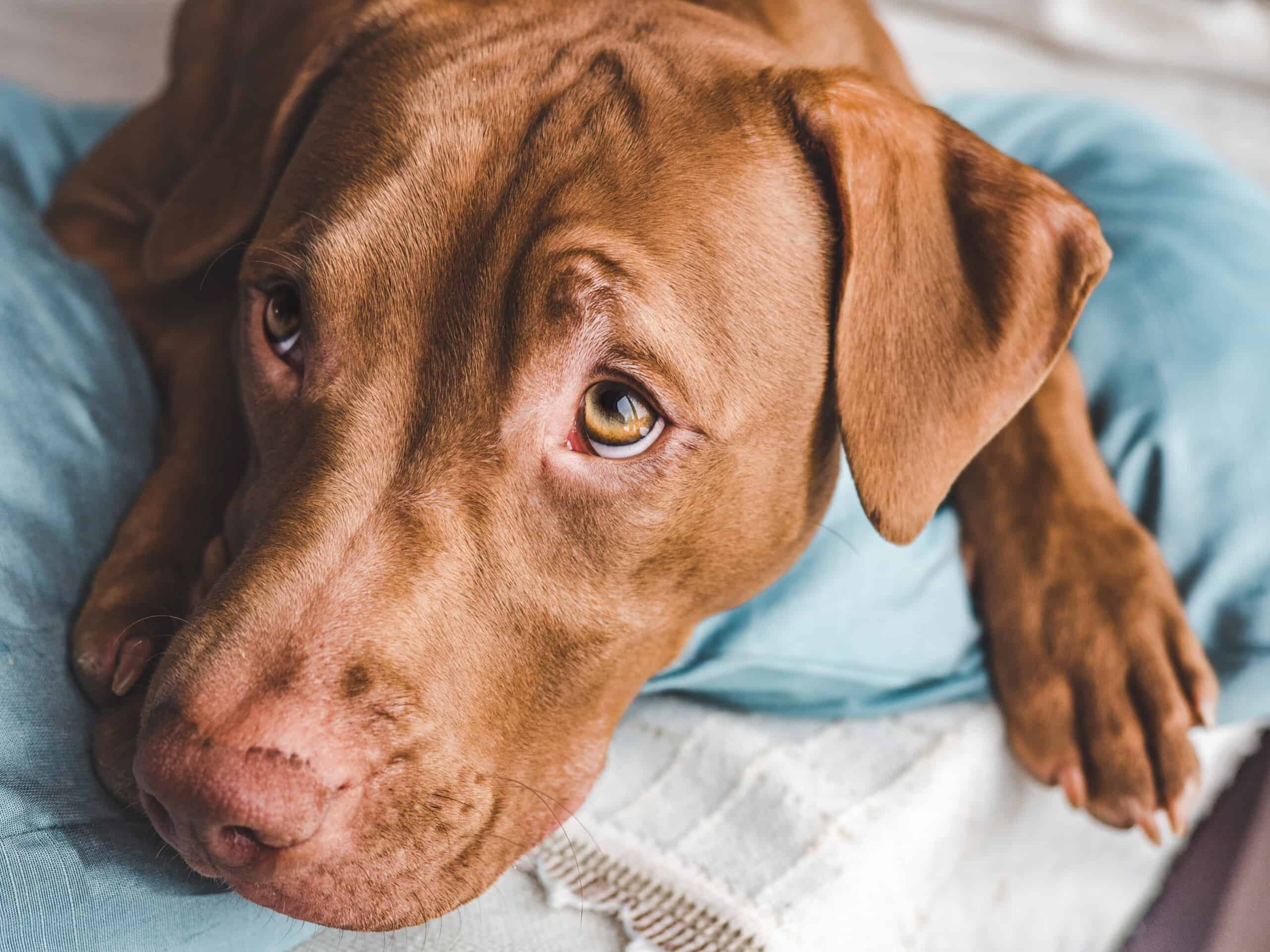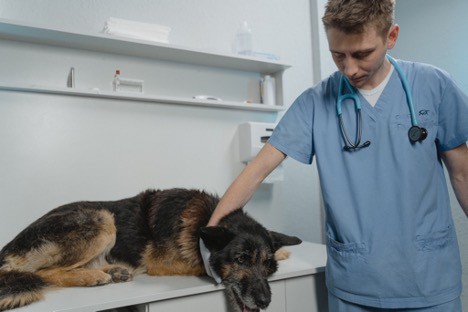Blood In Dog Stool: When Should I Be Worried?

One of the most concerning things you can see as a pet parent is blood in your dog’s stool. It’s a scary sight that will leave you with more questions than you can imagine. When you’re confused about blood in your dog’s stool, turn to our comprehensive guide. We’ll tell you everything you need to know about what blood in your dog’s stool means, when to worry, and how to treat it.
When to Worry About Blood in Dog Poop
There are few things more alarming than finding blood in your dog’s stool, but not all cases are life-threatening.
Bright red blood may not be a sign of a serious problem, especially if it’s a one-off occurrence and your dog has no other symptoms and is behaving normally. You should monitor your pup to make sure they don’t continue to bleed afterward. If you see bright red blood in multiple stools, especially over the course of multiple days, it might indicate an ongoing, more severe issue.
While a single stool with bright red streaks might not be a severe issue, if you see black or tarry blood in your dog’s stool, even just once, it is more serious, as it can indicate bleeding in the upper digestive tract.
Either way, you should call your vet immediately to let them know what’s happening. Using a telehealth chat like that provided by Odie is a good option to check with a licensed vet about the best course of action. Be as specific as possible about what you saw so they can advise you properly.
What Does Dog Poop with Blood Mean?
Blood in dog poop can indicate anything from a minor problem to a severe health condition. The color of the blood can help your vet accurately diagnose the problem, so it’s important to be aware and check thoroughly.
What Does Blood in Dog Poop Look Like?
Identifying the color of the blood in your dog’s stool cannot diagnose the issue by itself, but it will help you accurately describe the issue to their vet.
Bright Red Blood in Dog Stool
Bright red blood in dog stool is also known as Hematochezia. It can be a sign of bleeding in the colon or lower digestive tract.
Black or Tarry Blood in Dog Stool

Black or tarry blood in your dog’s stool comes from digested blood. The medical term is Melena, and it’s a sign of bleeding in the upper digestive tract, which can be anything from the stomach to the small intestine.
Why Is My Dog Pooping Blood and Vomiting?
If your dog is vomiting and you see blood in your dog’s stool, you should seek immediate medical attention for your dog. The combination of these two symptoms together can be a sign of a life-threatening condition such as parvovirus or kidney failure, so it’s important to get them to the vet right away.
What Causes Blood in Stools in My Dog?
The color of the blood in your dog’s stool won’t tell you exactly what’s wrong, but it’s a good place to start. When you identify the type of blood you find in their stool, it becomes easier to have a conversation with your vet that results in the best treatment for your pup.
Causes of Bright Red Blood in Dog Stool
Bright red blood may point to a more serious issue, including these conditions:
Parvovirus
Parvovirus is a highly contagious viral disease that causes severe diarrhea and vomiting in dogs. It’s life-threatening and requires immediate veterinary care.
Parasites
Parasites like hookworms and whipworms can also cause bloody stool in dogs by irritating the intestinal lining.
Rectal injuries and intestinal blockages
Rectal injuries and intestinal blockages can cause bloody stool in dogs when they swallow bones or ingest foreign objects.
Tumors
Tumors in the digestive tract can cause bloody stool in dogs. They can be benign or malignant.
Inflammation
Inflammation of the intestinal lining, stemming from food allergies, inflammatory bowel disease, or infection, can present blood in your dog’s stool.
Hemorrhagic Gastroenteritis
Hemorrhagic gastroenteritis is characterized by severe bloody diarrhea in dogs. Stress is one of the most common causes of this condition.
Anal Gland Problems
Anal gland issues can also contribute to blood in your dog’s stool. When these glands become blocked or infected, they can rupture and lead to rectal bleeding that requires vet intervention for.
Causes of Black or Tarry Blood in Dog Stool
Black or tarry blood in your dog‘s stool may indicate a very severe, potentially life-threatening issue::
Blood Clotting Disorders
It is possible for pets with coagulation issues to experience internal hemorrhaging, resulting in black or tarry stools. These include:
- Von Willebrand Disease: Von Willebrand Disease is an inherited disorder resulting from a deficiency of Von Willebrand factor, a protein that helps blood clot. Pets diagnosed with this condition may experience excessive bleeding from minor injuries, nosebleeds, or prolonged surgical procedures.
- Hemophilia: Hemophilia, or blood clotting disorders in pets, are rare but potentially life-threatening blood conditions that occur due to an insufficient supply of certain clotting factors (specifically factor VIII in dogs), leading to uncontrollable bleeding that even minor injuries or surgery cannot stop.
- Anticoagulant Poisoning in Pets: Anticoagulant poisoning in pets is a potentially fatal condition caused by ingestion of substances that interfere with blood clotting, such as rat poison. Signs of an anticoagulant poisoning attack in pets include lethargy, loss of appetite, difficulty breathing, vomiting, and black or tarry stools.
Non-Steroidal Anti-Inflammatory Medication (NSAIDs)
Non-Steroidal Anti-Inflammatory Medication (NSAIDs) used to treat discomfort and inflammation in dogs may cause harm to the stomach lining, which results in abdominal flatulence and tar-colored excretion. Thus, discussing all related treatments with a vet before administering drugs is necessary.
Pepto-Bismol
This curing choice to rectify diarrhea and nausea contains bismuth subsalicylate that can discolor feces. If you have given your dog pepto-bismol and notice black or tarry feces within the next 12-24 hours, be sure to let your veterinarian know so they can evaluate whether the pepto-bismol is causing the discoloration.
Ingesting Toxins
Household items, such as cleaning products, pharmaceuticals, or poisonous vegetation, entered into the pup’s system can produce fatal consequences. Should one suppose his dog ingested a toxic material, they should contact a vet immediately.
Tumors or Cancer
Finally, tumors or cancer in the gastrointestinal sector can bring on black or tarry stools amongst dogs. This may manifest more predominantly in older pups and may even present itself with further signs, including body wasting, vomiting, and appetite loss.
What Else Can Cause Blood Stool In Your Dog?
Apart from the causes we explained above, a few other things may be causing your dog’s bloody stool. They range in seriousness, including:
- Eating foreign objects: Dogs love to explore their environment, which can sometimes result in eating things they shouldn’t. Plastic, bones, and other sharp objects can damage their intestines and cause bleeding.
- Rectal polyps and hemorrhoids: Growths in your dog’s rectum or anus can cause bleeding and discomfort during bowel movements.
- Impacted or infected anal glands: Dogs have two anal glands located on either side of their anus that secrete a substance that helps them mark their territory. Sometimes, these glands can get blocked or infected, which may result in bleeding.
- Kidney failure: Kidney disease is a common problem in older dogs, and one of the symptoms is bloody diarrhea.
- Pancreatitis: This condition is caused by an inflamed pancreas, which can result in vomiting, diarrhea, and bloody stools.
- Stress: Changes in your dog’s environment, separation anxiety, or fear can cause stress-related digestive problems.
- Dietary changes: Abrupt changes in a dog’s diet can cause diarrhea, which can sometimes be bloody.
How to Treat Dog Anal Bleeding or Bloody Stool
If you notice blood in your dog’s stool, you should take them to the vet immediately. Your vet will be able to examine them thoroughly and recommend further tests if they’re needed to get to the root cause of the bleeding.
They will also discuss the best treatment option for your dog based on the underlying cause. For instance, your dog may get an antibiotic prescription for an infection or need surgery to remove a foreign object.
With your vet’s approval, you may be able to alleviate the symptoms of bloody stools at home if your dog’s condition isn’t too serious. Here are some ways you can help your pup:
- Feed them a bland diet: Try feeding your dog bland foods, like boiled chicken and rice, to soothe their digestive system.
- Add fiber: Adding high-fiber foods, such as canned pumpkin, can help regulate your dog’s digestive system. Be careful! Too much fiber can cause further gastrointestinal distress like gas, diarrhea, or constipation – so be sure to discuss what type of fiber and how much is appropriate with your veterinarian so you don’t make the situation worse.
- Give them plenty of water: Dehydration worsens constipation, and diarrhea depletes the body’s water stores, so ensure your dog has plenty of fresh water for smooth digestion and replenishing any lost water from diarrhea.
- Incorporate probiotics: Probiotics can help restore the balance of bacteria in your dog’s gut and reset their digestive flow. FortiFlora supplements are an example of a probiotic supplement specially formulated and studied for the support of healthy digestion and gastrointestinal tract health in dogs.
Although these remedies can help your dog feel better, they can’t replace veterinary care. Always take your dog to the vet as soon as you notice blood in their stool to determine the underlying cause and get treatment advice.
Pet Insurance as a Preventative Measure
Pet insurance is an essential investment for all dog owners, and it should be treated with urgency now before it’s too late. Odie offers preventative care plans to help ease the burden of unexpected veterinary costs, including The Illness & Injury Plan and The Accident Only Plan. Comprehensive care plans start at $45 monthly for dogs, while the accident-only plan starts at $9 monthly.
What Does Pet Insurance Not Cover?
While pet insurance covers many conditions, it’s essential to note that it doesn’t cover everything. Some things not covered in Odie’s Illness & Injury Plan include:
- Pre-existing conditions
- Training/obedience class
- Breeding, pregnancy, or birth expenses
- Prescription food
- Boarding
- Cosmetic or elective procedures
- Biohazard fees
- Preventative Care
Review your policy carefully and ask your insurance provider any questions you have about what’s covered and what’s not before you buy.
What Does Pet Insurance Cover?
Odie’s Illness & Injury Plan covers tons of conditions to protect your pup, including:
- 24/7 Televet Chat
- Emergency vet visits
- Overnight hospital stays
- IV Fluids & Medications
- Medical Supplies
- Surgeries
- MRI/CAT Scans
- X-rays & Ultrasound
- Tooth Extractions
- And much more
FAQs
What Does It Mean When My Dog Poops Blood?
Blood in a dog’s stool could indicate any number of conditions, from infections and parasites to physical injuries and more. For the best possible diagnosis and care, always visit a veterinarian immediately if any blood appears in their stool.
Why Is My Dog’s Stool Bloody?
There may be various causes for why your pup has blood in their stool, such as infections, parasites, injuries, and tumors. Therefore it is vitally important that they see a veterinarian so you can establish its source.
What Home Remedies Can Treat Bloody Diarrhea in Dogs?
Home remedies may help treat bloody diarrhea in your canine companion, including feeding them a bland diet and increasing water consumption, along with probiotic supplements to aid recovery. Home remedies should never replace professional medical advice.
Final Thoughts
Blood in your dog’s stool could indicate any number of serious conditions, so if you detect blood, it’s crucial to visit their veterinarian immediately to get to the bottom of the source and get the appropriate treatment.
Pet insurance policies provide essential peace of mind when something goes wrong. Consider purchasing coverage ahead of time to lessen the burden of unexpected procedures and treatments.
Get a quote for affordable pet insurance today, or contact your vet for additional coverage options!
This article also provides a guide to understanding pet insurance.



